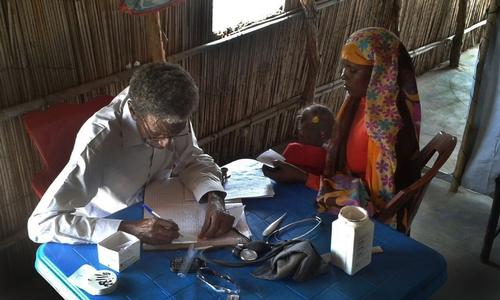Since February this year, Médecins Sans Frontières (MSF) has been providing medical assistance to over 30,000 South Sudanese who fled their homes to White Nile State in Sudan. Most of those arriving are from Upper Nile State, which borders Sudan to the south-east. Since the conflict started in South Sudan on 15 December, 2013, many South Sudanese have been internally displaced and others forced to seek refuge in neighbouring countries. Those arriving have told our teams that they have fled for fear of being attacked or after being attacked.
MSF, in collaboration with the Sudanese Ministry of Health, is providing medical care and nutritional support to those arriving in White Nile State. To date, the medical aid organisation has conducted over 36,174 consultations, vaccinated 2,333 children under 5 years old for polio, and 8,566 children under 15 years old for measles following a positive diagnosis. This preventive care approach has helped curb disease outbreaks in the area.
“Most of those arriving are women, children and the elderly; they are coming on foot or by public transport. Since some of them are in poor health and nutritional condition, we are conducting medical consultations and nutritional screening on arrival. Severely malnourished children are immediately enrolled into the therapeutic feeding programme, while supplementary food is provided for those moderately malnourished,” says Dr. Amir Osman, MSF medical team leader in White Nile State.
Currently, there are 3,230 people enrolled in the MSF therapeutic feeding programme. They receive regular medical check-ups and supplementary food. Malnourished pregnant and lactating women are also under close observation given the high numbers of women arriving. So far, MSF has conducted 2,111 antenatal care consultations with 152 safe deliveries.
Most of those in White Nile come from the four major towns of Waddakona, Kaka, Al-Renk, Malakal and their surroundings. All of them left due to insecurity, some managed to salvage a few of their possessions while others left with nothing. “I walked for three days from Waddakona, Upper Nile State to North Kweik, in Sudan, where I had to sell my cows, sheep and goats to get money for other necessities,” says Nyabok Adwok.* “I used to be a government employee and self-dependent, now I’m in another country and dependent on aid,” she adds.
Most people entered Sudan through the western area of the Nile and settled around Um Jalala area commonly known as ‘Kilo 10’ but have since been relocated to three transitional areas, namely Jorai, El Kashafa and El Rades. Some entered via the eastern side of the Nile settled in an area called Al-Alagaya. These areas are near the Nile in order to facilitate water transportation. Water transportation is especially important during the rainy season when roads become impassable and only boats can be used to transport patients with complicated medical cases across the River to hospitals in Kosti, the second capital of the state. In El Kashafa area, MSF has constructed a 20-bed clinic to be able to respond rapidly to critical cases while using mobile clinics to reach those in the other two transitional areas, which are about 7 and 15 km away, respectively.
The medical needs of the population are apparent; on average, MSF conducts over 4,300 consultations per month and refers about 15 cases to Kosti. Moreover, living conditions are very congested, with 6-7 people forced to live in a Tukul (hut) meant for 2-3 people. The congestion increases the spread of communicable diseases such as respiratory tract disease, one of the main illnesses that MSF teams in White Nile are treating. In order to help prevent the spread of communicable diseases as well as diseases associated with water, hygiene and sanitation, MSF has identified groups of community health workers to carry out health education activities.
Heavy rains may deter the numbers of those arriving as most people cannot cross the flooded river into Sudan. However, whenever renewed violence erupts in parts of South Sudan bordering Sudan, numbers automatically go up. Just a few kilometres of now watery border lines separate the two countries that a little over three years ago were one. Yet, despite the border that divides them, the commonalities and mutual relations between those arriving and the host community have eased acceptance and the two populations co-exist peacefully. Some even say that the host community is happy and protective of their neighbours from South Sudan, creating a secure situation favourable for the provision of aid.
*Not their real name.




